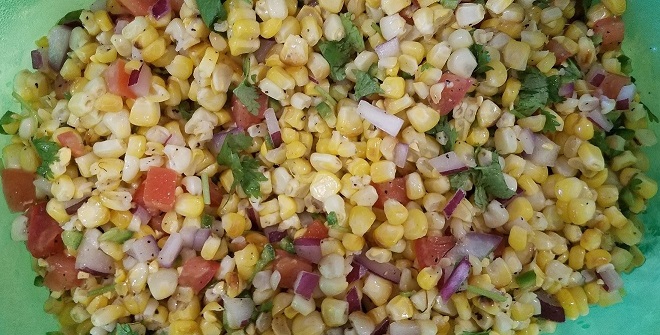This recipe was debuted at the Iowa State Fair as part of a Farm-to-Fork cooking series. Everybody in the audience wanted seconds! Now you can make it at home. Sweet corn is the star of the show so make this while it is still in season!
Ingredients
5 large ears of sweet corn, husked
2 Tbsp. corn oil
½ cup diced red onion
2 medium tomatoes, diced
2 Tbsp. red wine vinegar
1 medium jalapeno, diced
¼ cup cilantro, torn or chopped
Salt and pepper to taste
Directions
- Place the whole corn cobs on a hot grill for 3-4 minutes per side until slightly charred.
- Allow to cool slightly and then cut the corn off of the cob and place in a mixing bowl.
- Dice the red onion and add to small bowl with vinegar. Marinate for approximately 10 minutes until the onions change color slightly. Then add to the mixing bowl with the corn.
- Remove seeds from tomato and dice flesh. Dice jalapeno and add both to the mixing bowl with the corn.
- Toss corn and other ingredients with corn oil, salt, and pepper.
- Immediately before serving, mix in cilantro.
Where does it all come from? The story of the ingredients:

Sweet corn: Although Iowa farmers do raise some of the best-tasting sweet corn in the country, less than 1% of the corn in our state is sweet corn. Although one is considered a vegetable and the other a grain, sweet corn and field corn are close relatives. Sweet corn is a naturally occurring genetic mutation of field corn. The sweet corn plant is shorter, matures faster, and its kernels have a higher sugar content.
Corn oil: Corn oil is produced from field corn. 99% of the corn grown in Iowa is field corn. Field corn is harvested in the fall, after the plant dies and the seeds are dry and hard. Field corn has a much higher starch content and is used to make livestock feed, ethanol, corn meal, corn starch, corn syrup and more. The oil is pressed out of the corn kernel. Corn can be specifically processed for oil or the oil can be a by-product of the ethanol production process.
Red onions: The biggest onion producing states are Washington, Idaho, Oregon and California. Onions are a root crop that grow for 5-6 months before being either mechanically or hand harvested from the soil.
Tomatoes: Tomatoes are not widely grown in Iowa commercially. But they are an easy addition to a backyard garden. Most tomatoes will mature and produce fruit in 60-80 days. Tomatoes are a fruit because they carry the seeds of the tomato plant. In Iowa, tomatoes are typically grown in high tunnels that allow them to be planted as early as April. Tomatoes come in all shapes, sizes, and colors including red, orange, and yellow.
Red wine vinegar: Yeasts are added to the juice of grapes and yeast will convert the sugars to alcohol through fermentation. The result is of course wine. If left long enough, bacteria will convert the alcohol in the wine to acetic acid which is vinegar. Vinegars can take up to 10 years to make because of these two processes. But it all starts with grapes. The grape industry is growing in Iowa again. Iowa has more than 300 vineyards.
Jalapeños: Jalapeños are not the hottest pepper known to man, but they do offer considerable fire to any dish. Ripe jalapeños are 4-6 inches long, fat, and firm. They will turn bright green then darken to a deeper green before turning black and then red. You can harvest them at any point during the color transition. Jalapeños need up to 16 hours of daylight and at least 6 hours of direct sunlight. They grow best in the warm, dry climate of the southwest U.S.
Cilantro: Also known as coriander, cilantro adds a unique flavor to any dish. Alkaloids in the plant do make the taste unappealing for some people (they say it tastes like soap). Cilantro does best in well-drained soil in warm, but not hot temperatures. It bolts quickly (produces seed heads) so temperature must be maintained constant and the plants must be kept pinched back to produce maximum foliage. Grinnell, Iowa based Mariposa Farms herb growers commercially produce a wide range of herbs sold in locally grocery stores including cilantro.
Pepper: Black pepper comes from the fruit of a pepper plant species which grows in hot and humid tropical climates. The unripe dried fruit, called peppercorns, are ground into the spice we call pepper. Pepper was one of the spices that early explores traded because of its high value. It came from the spice islands of southeast Asia which also were known for nutmeg, mace and cloves.
Salt: Salt isn’t exactly an agricultural product. But, is an important component because it is the only rock that humans seek out and regularly consume. Salt can be harvested from salt pans (dried lakes) or mined from underground.
-Will